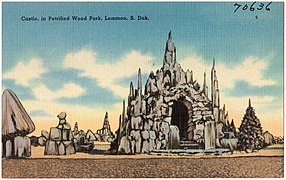
Lemmon is a town in Perkins County, South Dakota, United States. The population was 1,160 at the 2020 census.

Petrified Forest National Park is an American national park in Navajo and Apache counties in northeastern Arizona. Named for its large deposits of petrified wood, the park covers about 346 square miles, encompassing semi-desert shrub steppe as well as highly eroded and colorful badlands. The park's headquarters is about 26 miles (42 km) east of Holbrook along Interstate 40 (I-40), which parallels the BNSF Railway's Southern Transcon, the Puerco River, and historic U.S. Route 66, all crossing the park roughly east–west. The site, the northern part of which extends into the Painted Desert, was declared a national monument in 1906 and a national park in 1962. The park received 644,922 recreational visitors in 2018.
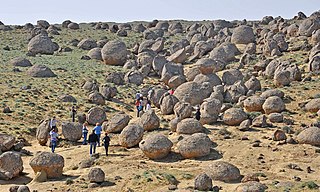
A concretion is a hard, compact mass formed by the precipitation of mineral cement within the spaces between particles, and is found in sedimentary rock or soil. Concretions are often ovoid or spherical in shape, although irregular shapes also occur. The word 'concretion' is derived from the Latin concretio "(act of) compacting, condensing, congealing, uniting", itself from con meaning "together" and crescere meaning "to grow".

Petrified wood, also known as petrified tree, is the name given to a special type of fossilized wood, the fossilized remains of terrestrial vegetation. Petrifaction is the result of a tree or tree-like plants having been replaced by stone via a mineralization process that often includes permineralization and replacement. The organic materials making up cell walls have been replicated with minerals. In some instances, the original structure of the stem tissue may be partially retained. Unlike other plant fossils, which are typically impressions or compressions, petrified wood is a three-dimensional representation of the original organic material.
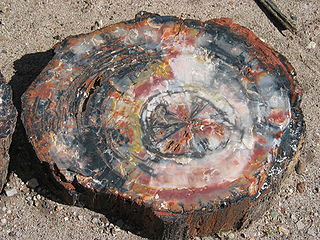
In geology, petrifaction or petrification is the process by which organic material becomes a fossil through the replacement of the original material and the filling of the original pore spaces with minerals. Petrified wood typifies this process, but all organisms, from bacteria to vertebrates, can become petrified. Petrifaction takes place through a combination of two similar processes: permineralization and replacement. These processes create replicas of the original specimen that are similar down to the microscopic level.
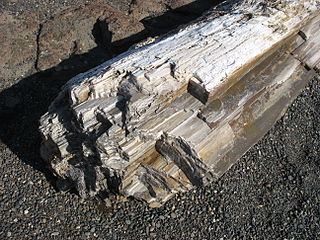
Ginkgo Petrified Forest State Park/Wanapum Recreational Area is a geologic preserve and public recreation area covering 7,124-acre (2,883 ha) on the western shoreline of the Columbia River's Wanapum Reservoir at Vantage, Washington. Petrified wood was discovered in the region in the early 1930s, which led to creation of the state park as a national historic preserve. Over 50 species are found petrified at the site, including ginkgo, sweetgum, redwood, Douglas-fir, walnut, spruce, elm, maple, horse chestnut, cottonwood, magnolia, madrone, sassafras, yew, and witch hazel.
The Wannagan Creek site is a fossil site found just west of the South Unit of Theodore Roosevelt National Park of North Dakota, US. The site is Paleocene in age, approximately 60 million years old. Paleontologists of the Science Museum of Minnesota have studied the site for nearly thirty years. The site is thought to represent a paleoenviroment of subtropical swampy lowland and forests. Preservation is excellent for both the flora and fauna of the site. Trace fossils of crocodilians and other vertebrates have also been discovered.

Cabazon Dinosaurs, formerly Claude Bell's Dinosaurs, is a roadside attraction in Cabazon, California, featuring two enormous, steel-and-concrete dinosaurs named Dinny the Dinosaur and Mr. Rex. Located just west of Palm Springs, the 150-foot-long (46 m) Brontosaurus and the 65-foot-tall (20 m) Tyrannosaurus rex are visible from the freeway to travelers passing by on Southern California's Interstate 10. The roadside dinosaurs are best known for their appearance in the film Pee-wee's Big Adventure (1985).

The Gallatin Range is a mountain range of the Rocky Mountains, located in the U.S. states of Montana and Wyoming. It includes more than 10 mountains over 10,000 feet (3,000 m). The highest peak in the range is Electric Peak at 10,969 feet (3,343 m).

Dinosaur Park is a tourist attraction and dinosaur park in Rapid City, South Dakota, United States. Dedicated on May 22, 1936, it contains seven dinosaur sculptures on a hill overlooking the city, created to capitalize on the tourists coming to the Black Hills to see Mount Rushmore. Constructed by the City of Rapid City and the Works Progress Administration, WPA Project #960's dinosaurs were designed by Emmet Sullivan. Sullivan also designed the Apatosaurus at Wall Drug nearby in Wall, South Dakota, the Christ of the Ozarks statue in Eureka Springs, Arkansas, and the dinosaurs at the now closed Dinosaur World in Beaver, Arkansas.

The Rice Northwest Museum of Rocks and Minerals is a non-profit museum in Hillsboro, Oregon, United States. Located just north of the Sunset Highway on the northern edge of Hillsboro, the earth science museum is in the Portland metropolitan area. Opened in 1997, the museum's collections date to the 1930s with the museum housed in a home built to display the rock and mineral collections of the museum founders. The ranch-style home is listed on the National Register of Historic Places, the first of its kind listed in Oregon. In 2015 the museum became a Smithsonian Affiliate museum.

This is a list of the National Register of Historic Places listings in Yankton County, South Dakota.

Araucaria mirabilis is an extinct species of coniferous tree from Patagonia, Argentina. It belongs to the genus Araucaria.
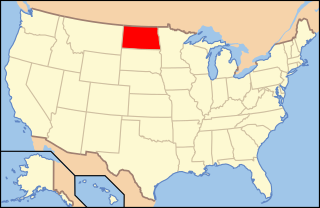
Paleontology in North Dakota refers to paleontological research occurring within or conducted by people from the U.S. state of North Dakota. During the early Paleozoic era most of North Dakota was covered by a sea home to brachiopods, corals, and fishes. The sea briefly left during the Silurian, but soon returned, until once more starting to withdraw during the Permian. By the Triassic some areas of the state were still under shallow seawater, but others were dry and hot. During the Jurassic subtropical forests covered the state. North Dakota was always at least partially under seawater during the Cretaceous. On land Sequoia grew. Later in the Cenozoic the local seas dried up and were replaced by subtropical swamps. Climate gradually cooled until the Ice Age, when glaciers entered the area and mammoths and mastodons roamed the local woodlands.
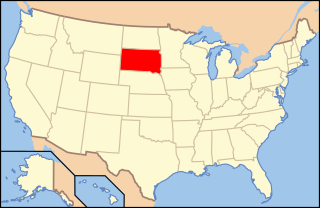
Paleontology in South Dakota refers to paleontological research occurring within or conducted by people from the U.S. state of South Dakota. South Dakota is an excellent source of fossils as finds have been widespread throughout the state. During the early Paleozoic era South Dakota was submerged by a shallow sea that would come to be home to creatures like brachiopods, cephalopods, corals, and ostracoderms. Local sea levels rose and fall during the Carboniferous and the sea left completely during the Permian. During the Triassic, the state became a coastal plain, but by the Jurassic it was under a sea where ammonites lived. Cretaceous South Dakota was also covered by a sea that was home to mosasaurs. The sea remained in place after the start of the Cenozoic before giving way to a terrestrial mammal fauna including the camel Poebrotherium, three-toed horses, rhinoceroses, saber-toothed cat, and titanotheres. During the Ice Age glaciers entered the state, which was home to mammoths and mastodons. Local Native Americans interpreted fossils as the remains of the water monster Unktehi and used bits of Baculites shells in magic rituals to summon buffalo herds. Local fossils came to the attention of formally trained scientists with the Lewis and Clark Expedition. The Cretaceous horned dinosaur Triceratops horridus is the South Dakota state fossil.
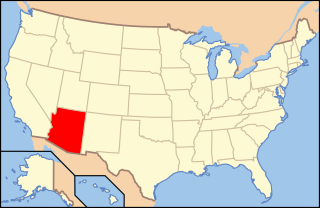
Paleontology in Arizona refers to paleontological research occurring within or conducted by people from the U.S. state of Arizona. The fossil record of Arizona dates to the Precambrian. During the Precambrian, Arizona was home to a shallow sea which was home to jellyfish and stromatolite-forming bacteria. This sea was still in place during the Cambrian period of the Paleozoic era and was home to brachiopods and trilobites, but it withdrew during the Ordovician and Silurian. The sea returned during the Devonian and was home to brachiopods, corals, and fishes. Sea levels began to rise and fall during the Carboniferous, leaving most of the state a richly vegetated coastal plain during the low spells. During the Permian, Arizona was richly vegetated but was submerged by seawater late in the period.

Paleontology in the United States refers to paleontological research occurring within or conducted by people from the United States. Paleontologists have found that at the start of the Paleozoic era, what is now "North" America was actually in the southern hemisphere. Marine life flourished in the country's many seas. Later the seas were largely replaced by swamps, home to amphibians and early reptiles. When the continents had assembled into Pangaea drier conditions prevailed. The evolutionary precursors to mammals dominated the country until a mass extinction event ended their reign.
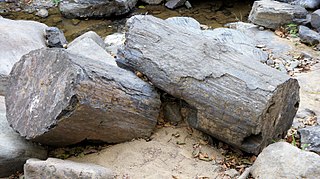
Puyango Petrified Forest is a fossil deposit of petrified wood located in the middle basin of the Puyango River, between the Ecuadorian provinces of El Oro and Loja. The area covers 2,658 hectares and its sediments are divided into four geological formations, dating from the late Cretaceous period. These deposits are rich in both fossilized trunks and leaves - which belonged to the typical Mesozoic flora - as well as fossils of invertebrates such as bivalves, ammonites, echinoderms, among others.






